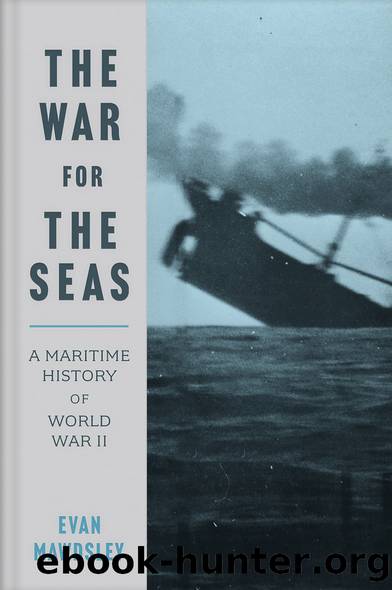The War for the Seas by Evan Mawdsley;

Author:Evan Mawdsley;
Language: eng
Format: epub
ISBN: 9780300190199
Publisher: Yale University Press
OPERATION TORCH
Various aspects of the execution of Operation TORCH, the giant landing operation in North Africa, have already been discussed. The object here is to put TORCH in context as the end-point of the first series of Allied amphibious operations, which began with the Lofoten raid. Some of same ships and forces took part, including the Princess Beatrix and Queen Emma (they landed American troops west of Oran). These vessels from the Lofotens, however, were now crowded out by an armada of other transports.
The British and American decision to strike in North Africa was made at the highest level in late July 1942. It came after the postponement of the projected cross-Channel operations, and it marked the success of British strategy over the version preferred by the American military leaders. Operation TORCH was another example of âhitting âem where they ainâtâ â to use the much-quoted tactic from American baseball â although this time on a strategic scale. On the day of the landings there were no German combat forces in Morocco, Algeria or Tunisia. At the same time, as outlined earlier in this book, TORCH was a very ambitious operation, much larger in scale than Madagascar or Dieppe (or Guadalcanal). Allied forces converged from Scotland and the East Coast of the United States. Command of the Atlantic gave the Allies the oceanic flexibility required to accomplish this, and to achieve complete surprise.
The plans for the TORCH amphibious operation were worked out very rapidly, in August and September 1942.21 For six weeks, high-level arguments went on about which points in northwest Africa to attack. The Americans wanted to be sure of a secure port on the Atlantic coast of Africa in the event that the Germans â perhaps with Spanish help â closed the Strait of Gibraltar; this worst-case scenario would have trapped an Allied force landed on the Mediterranean coast of Algeria. Other Allied planners, mainly on the British side, discounted the Spanish danger and wanted the naval landings extended east towards Tunisia, or at least to eastern Algeria. From there Allied forces would be poised to cut all the supply lines to Axis forces in Libya and Egypt, and to prevent enemy troops and aircraft arriving in North Africa from across the Mediterranean.22 However, only a limited number of Allied troops and landing craft were available, and the objectives could not be too close to enemy air bases in Sicily and Sardinia. At the time that the Allied staffs were working out their plans, the dangers of air and naval attack in the Mediterranean still appeared extreme. In the hard-fought Malta convoy of August 1942 (Operation PEDESTAL) two-thirds of a convoy of fourteen merchant ships had been lost.23 In the end it was decided to make three major landings, at Casablanca in Morocco, and at Oran and Algiers in Algeria.
The command arrangements for TORCH were complex. The landing operation was not only much larger than its predecessors but, unlike them, it was inter-Allied. A joint headquarters was set
Download
This site does not store any files on its server. We only index and link to content provided by other sites. Please contact the content providers to delete copyright contents if any and email us, we'll remove relevant links or contents immediately.
| Africa | Americas |
| Arctic & Antarctica | Asia |
| Australia & Oceania | Europe |
| Middle East | Russia |
| United States | World |
| Ancient Civilizations | Military |
| Historical Study & Educational Resources |
Magic and Divination in Early Islam by Emilie Savage-Smith;(1500)
Ambition and Desire: The Dangerous Life of Josephine Bonaparte by Kate Williams(1344)
Bohemians, Bootleggers, Flappers, and Swells: The Best of Early Vanity Fair by Bohemians Bootleggers Flappers & Swells- The Best of Early Vanity Fair (epub)(1343)
Papillon by Henry Charrière(1309)
Twelve Caesars by Mary Beard(1256)
Operation Vengeance: The Astonishing Aerial Ambush That Changed World War II by Dan Hampton(1134)
What Really Happened: The Death of Hitler by Robert J. Hutchinson(1128)
London in the Twentieth Century by Jerry White(1112)
Time of the Magicians by Wolfram Eilenberger(1087)
The Japanese by Christopher Harding(1086)
Twilight of the Gods by Ian W. Toll(1084)
Lenin: A Biography by Robert Service(1043)
The Devil You Know by Charles M. Blow(985)
A Social History of the Media by Peter Burke & Peter Burke(936)
Freemasons for Dummies by Hodapp Christopher;(922)
Napolean Hill Collection by Napoleon Hill(902)
Henry III by David Carpenter;(891)
The Churchill Complex by Ian Buruma(881)
The Rise and Triumph of the Modern Self by Unknown(877)
